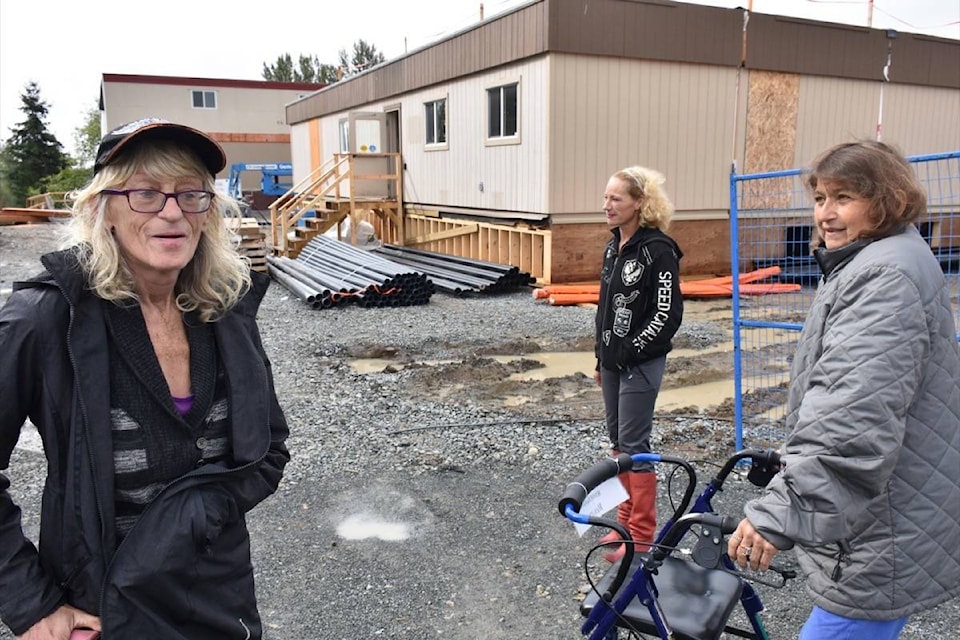The modular homes on Royal Crescent are now full, with people from Anita Place Tent City, the Salvation Army emergency shelter and others who have been couch surfing and sleeping in cars, now occupying the 53 units.
However, about another 65 people still remain in tent city, which now faces its second winter at the bottom of 223rd Street beside the Haney Bypass.
Laura Mathews, with B.C. Housing, said Monday that 25 people from Anita Place have moved into the temporary modular housing complex.
Another 18 moved in from the Salvation Army and 10 came from the streets, the bush or living in vehicles in and around Maple Ridge.
B.C. Housing said outreach workers are trying to find apartments, with the assistance of 40 rental supplements, for those remaining in tent city.
Anita Place residents can also move into the resulting vacancies in the 60-bed Salvation Army emergency shelter or use the mat program operated by Hope for Freedom Society. The latter gives shelter, on a nightly basis during the winter, by providing 20 mats to sleep on in local churches, staffed by volunteers.
However, B.C. Housing hasn’t given up on building a permanent supportive housing complex in Maple Ridge.
“We understand the demand for supportive housing in Maple Ridge exceeds the supply,” said Mathews.
“Our primary focus will be working with the new council to expedite the development and construction of both new affordable seniors and family units, and new permanent, supportive housing units in the community.”
Maple Ridge council, last spring, rejected an 85-unit supportive housing and shelter complex on Burnett Street.
B.C. Housing has said it’s now up to the city to find a different location for a supportive housing complex.
Coun. Gordy Robson said he hopes that with the opening of the modular homes a speedy clearing of the camp can occur under the direction of B.C. Housing.
He questioned whether Maple Ridge needs a 85-unit supportive housing complex.
“If they’re after another low-barrier shelter, the answer is no, at least as far as I’m concerned.”
He said the 94-unit affordable housing complex being built by Maple Ridge-Pitt Meadows Community Services, on 227th Street and 119th Avenue, can function as a transition facility for people from the street.
He said the city’s social housing policy should, in the future, provide money that the city can use to buy land and provide housing through partnerships.
Rob Thiessen, with the Hope for Freedom Society, which operates the mat program, said that currently about 10 of those mats are occupied each night, with some of those by people from tent city.
He expects occupancy to increase as the weather gets colder.
B.C. Housing announced Coast Mental Health as the operator last April and said that it will provide daily meals, access to mental health and addictions treatment, as well as life skills programs.
Susan Hancock, with Coast Mental Health, said that it will ensure that residents get mental health or addictions care either within Maple Ridge or outside the community.
Fraser Health is one resource, she added.
“One of our values is to be client-focused. So our goal is to find the resources that our clients need to support them, wherever they’re at in their recovery,” Hancock said.
She said life skills programs, such as personal cooking, could be offered on site because the modular facility has an industrial kitchen.
“Those are going on at most of our housing programs. Different types of housing … those types of programming are going on in each scenario.”
The facility is a low-barrier facility that follows the Housing First principle.
“At the end of the day, our first priority is putting people into homes and giving them the space they need, wherever they’re at, to start their recovery. And that often means that some people will have addiction problems,” Hancock said.
All of the staff have key clients for which they’re responsible to help in recovery, she added.
She said the intent is to move people through their recovery process and to help them move to the next step in housing as they get better.
“It’s definitely not the case that we would encourage people to just sit.”
She added that residents are looking forward to being housed.
“We’re very positive about the project. It’s a new start for them.”
